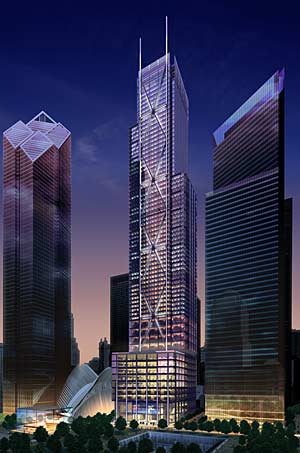Construction on two towers at the World Trade Center, designed by Richard Rogers and Fumihiko Maki, will begin this week—or by the end of the month, depending on whom you believe, and whether or not you consider test blasts to represent the start of foundation work. A March 13 article in the New York Post says “this week,” whereas The New York Sun wrote that it would be “later this month” when workers begin “foundation work” following this week’s test blasts. Both papers were reporting on remarks made by developer Larry Silverstein during a speech at the New York Building Congress, where he said of the project, “We have finally reached the day when we are able to hand the ball to you in the design and construction industry.” The Port Authority of New York and New Jersey gave Silverstein control of the sites for World Trade Center Towers 3 and 4 in February. As RECORD reported, Silverstein unveiled designs for these buildings, which are due to rise 1,174 feet and 975 feet, respectively, in September. At that time he also unveiled Norman Foster’s design for Tower 2, a 1,270-foot-tall building that Silverstein said yesterday would top out in 2011, a year after the other two towers. Work will finish on all three towers by December 2012. Speaking on Thursday, the Post reported, Port Authority Executive Director Anthony Shorris said that “in the coming months, there will be as many as 10,000 construction workers at the site, calling the project ‘an incredible construction machine.’” Doubtless that Silverstein is also hoping his real estate brokers will be working equally as hard to find tenants. The Sun wrote that Silverstein expects to “leapfrog” over a market slowdown: “At the moment we are going through a much more difficult time, and presumably by the time these buildings are done those circumstances will be well be behind us.”
![]()
Listen to a podcast of these headlines and more.
Click the play button to begin | Click here to download

Daniel Libeskind’s recent addition to the Royal Ontario Museum, in Toronto, is “an ideal icicle machine” thanks to the crystal-shaped building’s “precariously angled aluminum and glass facades,” the Toronto Star reported on March 11. Noting that the museum’s angled facades allow snow to accumulate, and are made of materials that “absorb heat from sunlight, melting the snow that then drips and freezes,” the paper’s architecture critic Christopher Hume wrote that “if Libeskind had set out specifically to design a building that endangers passersby with falling ice, he couldn’t have done better.” To be fair, Hume adds that falling ice is a “rite of spring” throughout the city’s downtown district—and when it comes to well-known architects whose buildings are icy, Libeskind shares good company. As RECORD has reported, icicles are among the many woes that a Massachusetts Institute of Technology lawsuit alleges are plaguing the school’s Stata Center, designed by Frank Gehry. Hume notes there are also historical precedents, such as Le Corbusier’s villa for Madame Savoye: “The Villa Savoye became one of the most celebrated buildings of the 20th century. But Madame Savoye was so upset by the leaky roof, she threatened to sue. This is no excuse, of course, but it reminds us that despite reports to the contrary, architects are human after all.” Maybe so, but will the Royal Ontario Museum sue Libeskind? Hume’s article steers clear of that one.
Calling all architects—the New York Public Library wants you. The venerable institution announced on Tuesday that it is embarking on a $1 billion capital campaign, jumpstarted by a $100 million donation to revamp its main building on Fifth Avenue at 42nd Street, according to a March 11 article in The New York Times. Designed by Carrère and Hasting, the central library is a Beaux Arts structure that dates to 1911. Although a tourist magnet, it has been non-circulating since 1970—paperbacks, DVDs, and other circulating items are housed in a dingier building across the street. As part of a system-wide reorganization, which includes the creation of large “hub” branches in the three New York City boroughs that the library serves, the central building will once again feature a circulating collection. The Times wrote: “The new circulating library will be situated in a vast space that currently houses eight levels of stacks below the Main Reading Room and overlooks Bryant Park through strip windows. The stacks will be moved to an existing three-acre storage area beneath the park, opening the way for the space to be gutted and reconfigured with new rooms for children and teenagers and ample computer work stations.” Further work will see the creation of “a new cafe and information center to enliven Astor Hall just inside the Fifth Avenue entrance, wireless Internet access throughout the building, refurbishment of branch libraries and the creation of two new libraries in Upper Manhattan and Staten Island.” Architects for these projects have not yet been selected. The paper added that while the central library is landmarked, which limits the scope of alterations to its exterior, one small change will be made: the building will be renamed in honor of Stephen A. Schwarzman, chief executive of the Blackstone Group, whose name will be etched on its stone facade in recognition of his $100 million gift.

Post a comment to this article
Report Abusive Comment